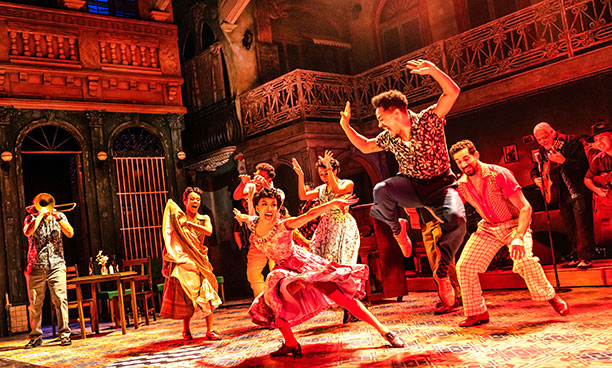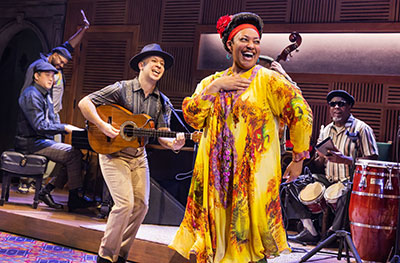
His work on the vibrant and fast-paced Buena Vista Social Club musical on Broadway recently won sound designer Jonathan Deans his first Tony Award for Best Sound on a Musical.
Included in his design – keeping ten Cuban musicians locked tight into the rhythm – was an ingenious use of TiMax TrackerD4 precision stagetracking.
With the production sound package supplied by PRG, this previously unseen solution was created to counteract the challenges discovered earlier by Deans: ‘I learned a lot about the music and musicians and what needed to be done,’ he says of the show’s prior off-Broadway stint. ‘Cuban music, it was explained to me, is like a watch. The cogs all must work together and if we miss one, it doesn’t work. It’s fascinating, as all ten of the musicians are the hub. There’s not one person who leads, they are all playing off each other both with rhythm, pitch and tone and who steps forward, so getting the monitoring right and natural for them was the key to success.’
Deans quickly discounted in-ear monitoring as an solution due to limitations including interaction and safety. The roving musicians had to engage and respond also as actors whilst authenticity was a further consideration. As the production is set across two time zones, the 1950s and 1990s, visually obtrusive foldback was considered inappropriate, as well as being impractical due to space.
Instead, a trend increasing in popularity amongst sound designers was adopted, with Deans distributing monitor speakers in the floor to deliver a more consistent level across the entire stage with the even coverage at ear height. The original off-Broadway production saw sound operators taking multiple cues to support the ten musicians need to focus closely on each other to form the pivotal hub of the Cuban musical phenomenon they were creating on stage.
‘That way of working wasn’t that successful for them and certainly not for Timothy Jarrell the FOH mixer,’ Deans says. ‘And although it was successful for the audience, it just wasn’t as pleasing for the ten musicians. That’s when I thought of tracking the Musicians as a solution.’
 Instead of using TiMax TrackerD4 conventionally to follow the actors primarily to help the audience focus on the spoken word or the singing, Dean’s idea was to link the tracking system via two Meyer Sound Galileo Galaxy Network Platforms to Spacemap Go, so it could vary the foldback in real-time across up to 27 monitor speakers in the stage floor.
Instead of using TiMax TrackerD4 conventionally to follow the actors primarily to help the audience focus on the spoken word or the singing, Dean’s idea was to link the tracking system via two Meyer Sound Galileo Galaxy Network Platforms to Spacemap Go, so it could vary the foldback in real-time across up to 27 monitor speakers in the stage floor.
‘My understanding was that I could plan the speaker layout, the tri-sets and the crossfades in Spacemap Go, put a TiMax TrackerD4 Tag on a musician, and their mix would follow them around the stage – and it worked. It worked very successfully,’ he says. ‘It gave the musicians the freedom to move more freely without having to think about exactly where they are standing and the FOH mixer to concentrate on the sound for the Audience mix.’
This pairing of TiMax TrackerD4 with Spacemap Go marked another first: ‘Between David Strang from PRG, Robin Whittaker from TiMax and Steve Ellison and Rob Mele from Meyer Sound, they got together to make sure that the communication between the two devices worked really well. Both manufacturers had been looking for a project that would work to make the handshake between both systems completely solid, and this was it and it is now in place.’
A critical measure of the system success is that the safety backup measures that were in place for the production were never needed. Additiionally, the TiMax TrackerD4 integration brought a further benefit to the front-of-house mix. The tracked monitor mixes created stronger sound-focused anchors on-stage, which helped the fixed-delayed, audience PA system to localise the performers as they move around.
Another special feature used was TiMax TrackerD4’s capability to understand when each of the musicians had reached their ‘home’ position and stop tracking. This simple ‘trick’ prevented audio output swapping between two speakers in the floor, should the actors move around in their seat for example, which would cause confusion and a musical distraction.
The ultimate measure of success for Deans was the energy of the show. ‘The Cuban audience know the story and there’s always interaction, with them calling out and joining in. By the curtain call they’re all singing along and it’s a super cool show to see because of the energy.’
‘That is why it was so important to be able to track the performers, giving them what they needed to be able to play in the way they want to be able to play. The tracking gave fluidity, and it was intriguing to do and to see the results.’

